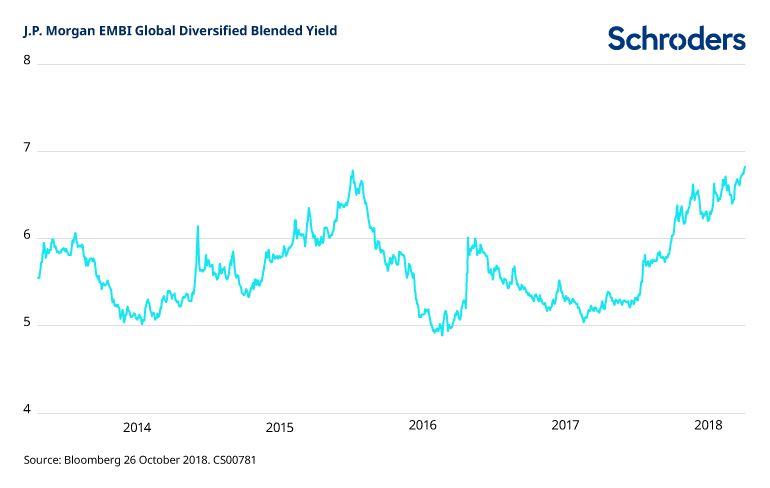
Schroders: Emerging markets debt relative
Emerging markets debt yields are at levels which rival reasonable forward expectations for equities in 2019. In our view, a true catalyst for additional price gains will likely be a lower US dollar.
17.12.2018 | 09:24 Uhr
Yields on US dollar emerging market debt are approaching 7% for the major indices, comparable to peak levels during the 2014-early 2016 emerging markets (EM) sell-off (see chart). Of course, with the risk-free rate rising, investors may not be comfortable even at those levels until there is greater clarity on where the terminal policy rate for the Federal Reserve (Fed) will be during this cycle.
With perhaps the best of US growth behind us in Q2 of 2018, the outlook for Fed policy should become clearer in 2019, enhancing the probability that the asset class will outperform a rare negative year across all major dollar and local currency indices. Significant strife emanating from within the asset class that would derail a price recovery is a low probability for 2019 in our view.

EM recovery well underway
Emerging markets enter 2019 well on the way to recovering from the negative effects of a stronger dollar and outsized US growth. These effects shifted liquidity away from the asset class, much as in the 2014-2016 period when the Fed first began ending quantitative easing and raising interest rates. Like that period, currencies have been the adjustment mechanism of choice for stressed countries.
So while local returns were deeply negative, countries for the most part avoided spending precious foreign exchange reserves in a futile search for currency stability. Thus, when the smoke begins to clear, countries generally find that creditworthiness has not deteriorated significantly, dollar debt is not perceived to be seriously at risk of default, and a slow recovery of growth can begin. Broadly, that is where the asset class finds itself.
In 2018, Turkey and Argentina were the most severely stressed countries but both seem to have done enough to stabilise currencies and external deficits at levels that markets are now comfortable with. In other less vulnerable countries like Indonesia and Mexico, interest rates have been increased but not to levels that would cause significant slowdowns into 2019. Growth in the asset class should recover slowly and major recessions in key countries are unlikely.
EM dollar debt outlook favourable but local currency bonds remain challenged
We see the prospects for dollar debt in EM as being very favourable. Yields on non-investment grade debt have steepened considerably faster than those of investment grade. As pressures on the asset class ease, historically that has reversed fairly quickly. Even if one assumes a slower recovery for prices, yields at 8% and above on average offer investors a cushion not available in other liquid fixed income asset classes.
Until the dollar definitively heads lower, local currency bonds as a whole will be challenged to deliver returns comparable to dollar bonds. Yields on the local currency index are now roughly flat to dollar index yields, whereas the historical average is about a 100 basis points yield differential for local debt. Though yields indeed rose in local bonds, they did not rise as quickly in aggregate, as many countries in Central Europe, Asia, and Latin America did not feel pressured to raise interest rates to help defend currencies.
It will take a quite unambiguous turn in the US dollar to allow investors to benefit from sustained currency rallies across the asset class in our view. If the Fed remains on the current hiking path, that may be an event beyond 2019.
Die hierin geäußerten Ansichten und Meinungen stellen nicht notwendigerweise die in anderen Mitteilungen, Strategien oder Fonds von Schroders oder anderen Marktteilnehmern ausgedrückten oder aufgeführten Ansichten dar. Der Beitrag wurde am 14.12.18 auch auf schroders.com veröffentlicht.




Diesen Beitrag teilen: